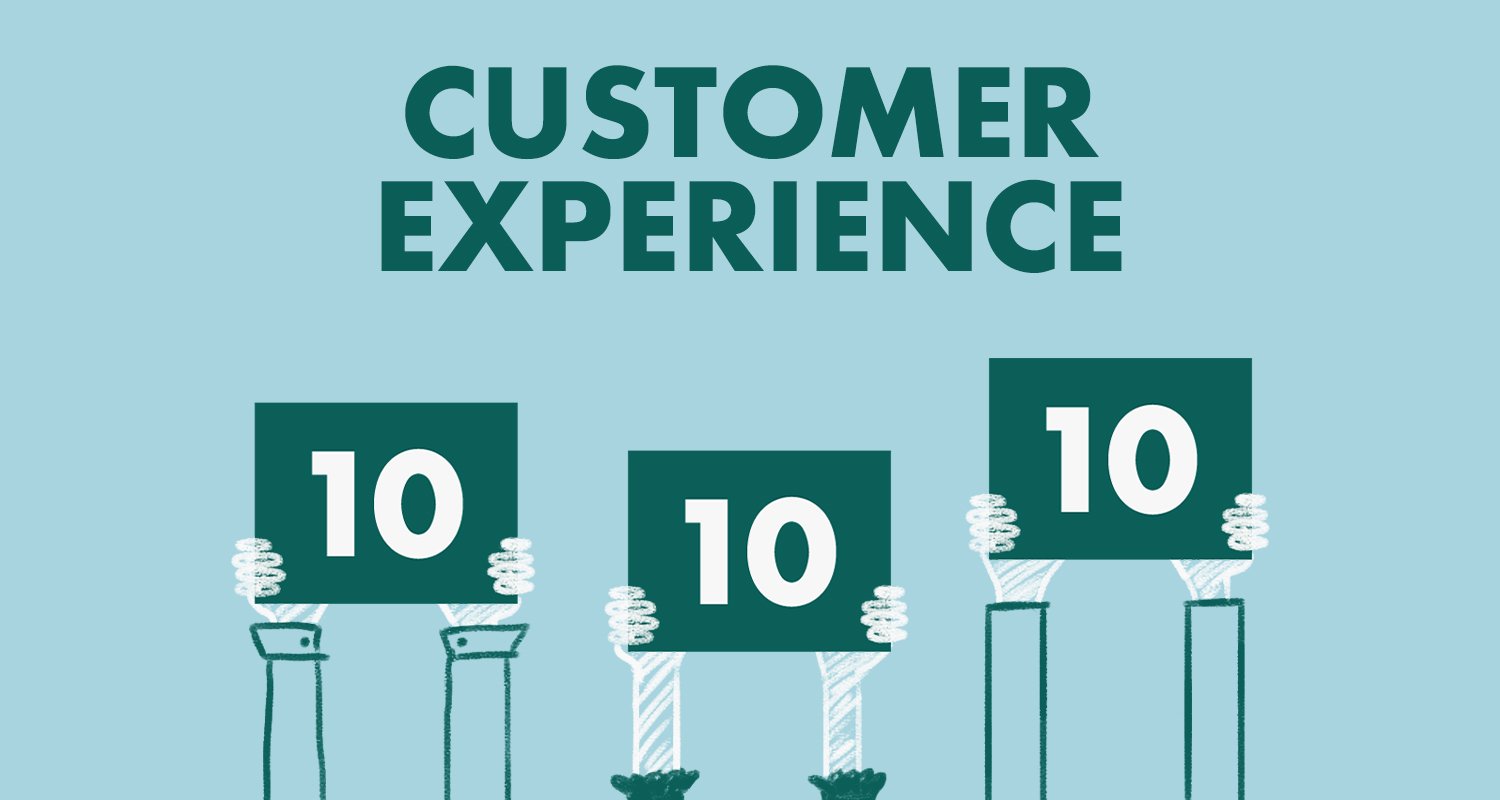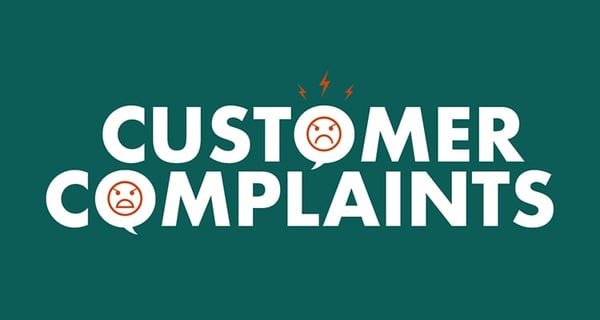How do you win new customers?
Every business claims that it’s in the quality of the product or service they deliver.
While that might have been true two-three years ago, it’s no longer the reason why customers choose to do business with a company.
Today, it’s all about providing the best customer experience.
We recently asked 1,920 business professionals to share their number one priority for the next 5 years.
The results?
Customer experience (or CX) came in first - beating product and pricing for the third time in a row.

Truthfully, it’s no surprise that customer experience is the number one priority.
The Temkin Group found that companies that earn $1 billion annually can expect to earn, on average, an additional $700 million within 3 years of investing in customer experience.
For SaaS companies in particular, they can expect to increase revenue by $1 billion.
That's right.
Investing in CX initiatives has the potential to double your revenue.
So, where is this revenue growth coming from?
A good customer experience leads to your customers spending more.
In fact, 86% of buyers are willing to pay more for a great customer experience.
And according to a research from PWC, the more expensive the item, the more they are willing to pay.
For example, customers are willing to pay a price premium of up to 13% (and as high as 18%) for luxury and indulgence services, simply by receiving a great customer experience.
CX also influences on-the-spot purchasing, too - as 49% of buyers have made impulse purchases after receiving a more personalized experience.
But the most convincing reason why CX has become so important is this:
81% of organizations already cite CX as a competitive differentiator.
If CX is to play an important role in your plans this year, use this article to stay ahead of the top customer experience statistics and trends in the upcoming year.
At SuperOffice, we've helped thousands of companies use B2B sales, B2B marketing and customer service to improve the customer experience.
This gives us access to data and insight into how consumers feel about the experience they receive - which we'll be sharing in this report.
Unlike other lists, these CX stats are completely up to date.
What is customer experience?
Customer experience is your customers’ perception of how your company treats them. These perceptions affect their behaviors, and build memories and feelings to drive their loyalty.
In other words – if they like you and continue to like you, they are going to do business with you for a long time and recommend you to others.
But, in order for your customers to like you, you need to get to know them. You need to invest in the long-term relationship (also known as relationship marketing), because when you understand who they are, you are able to deliver a personalized experience across the entire customer journey.
Acquiring this in-depth knowledge about customers isn't something that just happens. You need to collect customer data (i.e.Voice of Customer data) and bring out valuable insights from that data with speed and precision.
The good news is that it doesn't matter what kind of business you're in - improving the experience for your customers has been proven (time and time again) to increase retention, satisfaction and revenue.

So, what can you do to create a positive customer experience?
Let's take a look at the most important trends.
1. Customer experience is the new battlefield
No one wants to do business with a company that treats you poorly.
And how you feel after an interaction with a customer service center has a huge impact on your future purchase decisions. A good interaction keeps you happy and satisfied, while a poor interaction could lead to you stop doing business with that company again.
It’s because of these extremes why 88% of companies now prioritize customer experience in their contact centers. Yes, it’s that important.
And it’s easy to see why. If a customer is choosing to do business based on CX, then that’s where you have to stand out!
In fact, more than two-thirds of companies now compete primarily on the basis of customer experience – up from only 36% in 2010!
Therefore, if you want your customers to have a positive experience, you have to invest in it.
It makes sense, right?
The sad news is that less than half of all organizations will be investing in the customer experience next year.
In fact, our own research found that only 44% will increase the investment in their CX initiatives.
 But if you are investing in CX, where do you begin?
But if you are investing in CX, where do you begin?
According to Gartner’s research, companies that successfully implement customer experience projects begin by focusing on how they collect and analyze customer feedback.
Whether you use surveys, web forms, or Net Promoter Score (NPS) programs, read through their comments, suggestions and opinions to see what they expect from you. Then, invest in those projects to meet their expectations.
2. Omnichannel customer service will increase
A customer contacts you on the platform of their choice.
And unlike the 90s, when there was only telephone (or fax, remember those?), today’s customers are active in dozens!
In turn, companies are forced to interact with their customers across multiple channels, through forms on their website, live chat, social media and more.
However, while customers may be positive and accept different service levels from different channels, they also expect that the communication remains consistent. This is known as omnichannel.
How do you provide a consistent experience across all channels, both online and offline?
A great example of a company that does this well is IKEA.
If you visit any IKEA store around the world, you will get the same consistent experience. IKEA invests heavily into customer experience.
They've opened more stores, invested in their home delivery network and launched a brand new app - all to the benefit of their customer.
And the pay off has been huge!
Not only is IKEA one of the most beloved companies in the world, but their annual revenues have now reached more than $40 billion worldwide.
And it’s this level of execution and result that is driving more companies to invest in the omnichannel experience.
In fact, in a retailing report, PWC found that the number of companies investing in the omni-channel experience has jumped from 20% to more than 80%.
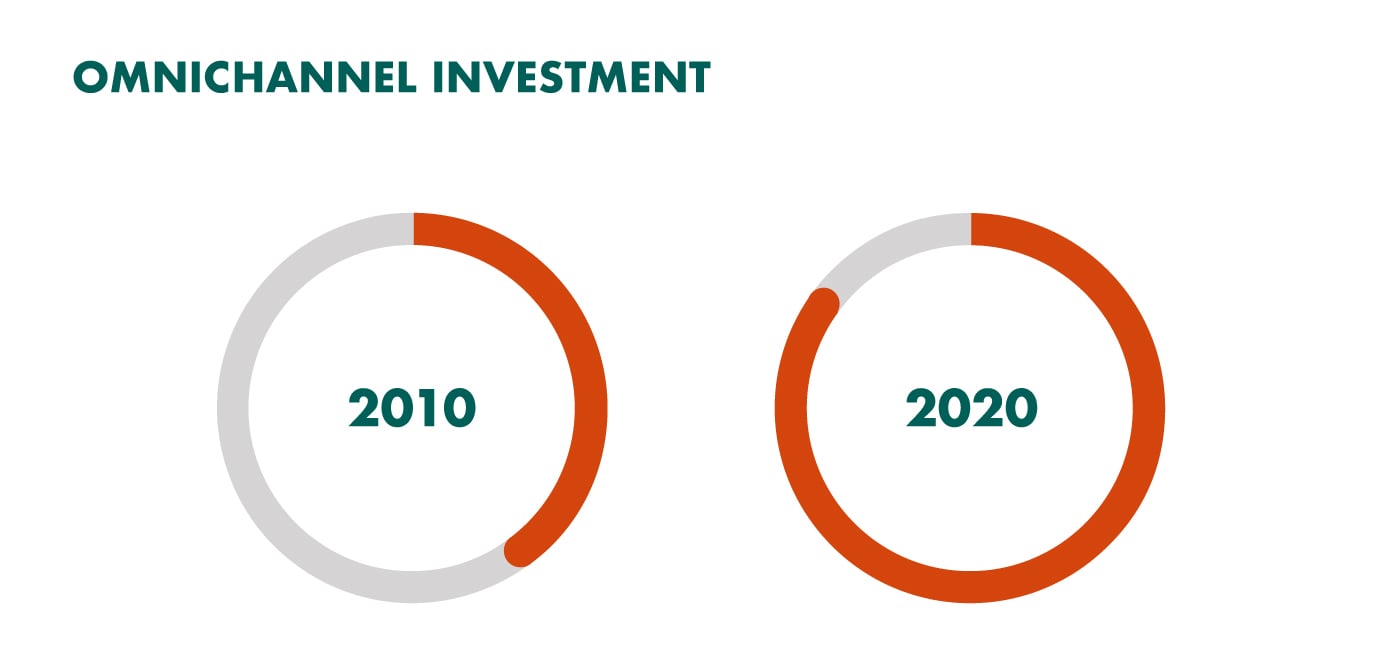
Adding to this, Adobe recently found that companies with the strongest omni-channel customer engagement strategies enjoy a 10% Y-O-Y growth, a 10% increase in average order value and a 25% increase in close rates.
3. Mobile customer experience is priority
A poor mobile experience can do serious damage to your brand.
For example, 57% of customers won’t recommend a business with a poorly designed website on mobile. And if a website isn’t mobile-friendly, 50% of customers will stop visiting it, even if they like the business.
By not providing a positive mobile experience, you’re putting business growth in jeopardy, as the graphic below shows.
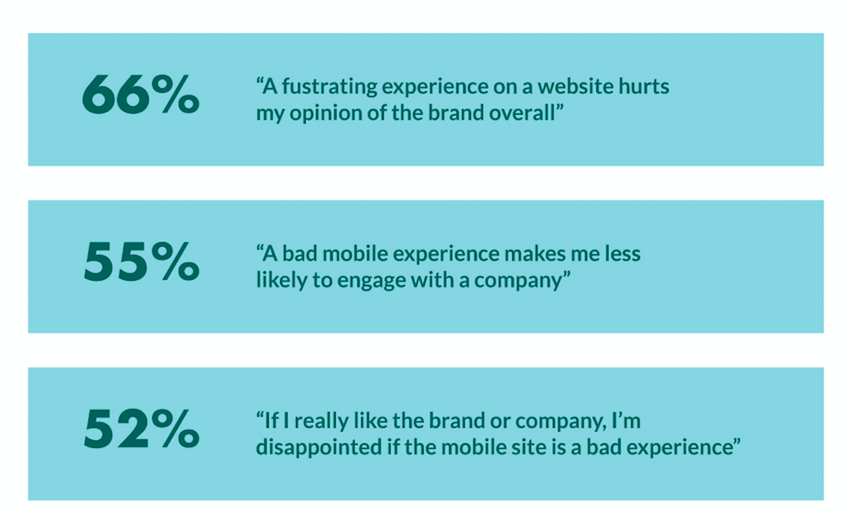
It’s no longer the question whether the mobile experience is important or not.
Today, it's considered a best practice for great customer experiences.
According to Statista, 59% of all internet traffic worldwide now comes from mobile.
So it comes as no surprise why 84% of companies who claim to be customer-centric are now focusing on the mobile customer experience.
If you are using a CMS platform like WordPress or HubSpot, there are tools to help with mobile optimization like spacing, text size, and more.
However, for companies that aren’t, they’ve been slow to adapt to this trend – especially when it comes to customer support – as an overwhelming 90% of customers report having a poor experience when seeking customer support on mobile devices.
The most common customer complaints are navigation, site search and load times.
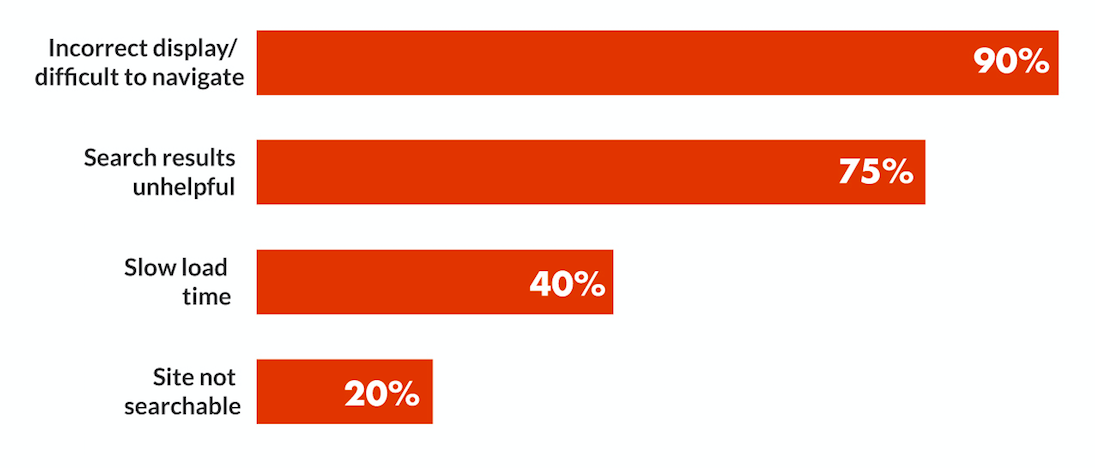
There is a huge gap that needs to be taken seriously.
If your customers cannot navigate your website with ease and find what they are looking for, then you frustrate them. And you lose them.
4. Customer frustration will lead to churn
According to Esteban Kolsky, 72% of customers will share a positive experience with 6 or more people. On the other hand, if a customer is not happy, 13% of them will share their experience with 15 or even more.
The CX challenge here lies in the fact that, in most cases, customers don’t tell you they’re unhappy. In fact, only 1 in 26 unhappy customers actually complain.
The rest? They just stop doing business with you.

For many companies, the absence of negative feedback is a sign of satisfaction.
But as the research shows, that's not the case. Your customers may not be happy, or worse, they’re sharing their bad experiences with others.
Customer expectations are at an all-time high and it’s a tough time for companies to meet and exceed them.
Even if you provide a positive customer experience 9 out of 10 times, that one time you do not could be fatal.
In their future of CX report, PwC surveyed 15,000 consumers and found that 1 in 3 customers will leave a brand they love after just one bad experience, while 92% would completely abandon a company after two or three negative interactions.
What accounts for a bad experience?
Sometimes, it’s as simple as poor follow-up.
Our own research found that very few companies follow up with their customers. Put simply, you can avoid many of these poor experiences by sending a follow-up email.
5. Self-service help will be the first choice
This year, companies should ensure that customers are able to find answers to their questions using a wide-range of self-service options.
Today, 67% of customers prefer self-service over speaking to a company representative.
Furthermore, 91% of customers would use an online knowledge base, if it were available and tailored to their needs.
Customers are willing to find the answers themselves. So much so, that by 2030, Gartner estimates that a billion service tickets will be raised automatically by customer-owned bots.
To handle this demand, companies are turning to Artificial Intelligence (AI).
Three years ago, 25% of all customer interactions were automated through AI and machine learning. Today, this number has reached 40% (and continues to grow).
In the short-term, you need to make sure that when a customer has a problem, the right tools are available to them, so they can solve it, themselves.
In the long-term, you need to think about how AI and technology can help you improve customer experience.
6. Customers demand immediate attention
The most important factor in the customer experience?
Fast response times.

Yet, the average response time for customer service emails is 12 hours.
Clearly, there’s a disconnect. The longer it takes for a business to reply, the less likely it is that the customer will engage. If this happens regularly, then your customer will stop trying to contact you. Eventually, they’ll leave.
Are customers more demanding than ever before?
Maybe. But they deserve to be. Without them, you have no business!
Unless you’re Ryanair, most companies cannot afford to deliver poor customer service and still be profitable.They are the exception, not the rule.
Here’s the thing:
When it comes to the customer experience, your customers don’t care about how great your product or service is. All they care about is that if they have a problem, you are there to help them. And quickly.
7. Anticipate customer’s needs
It’s one thing to respond quickly.
It’s another thing altogether to communicate with customers before they need to contact you. That’s where the art of being proactive comes in.
Most companies provide reactive support. They wait until a customer contacts them and then they respond.
Proactive support is about solving customer issues before they become problems.
Essentially, you’re putting out fires before the match has been lit.
Here's how it differs to reactive customer service.
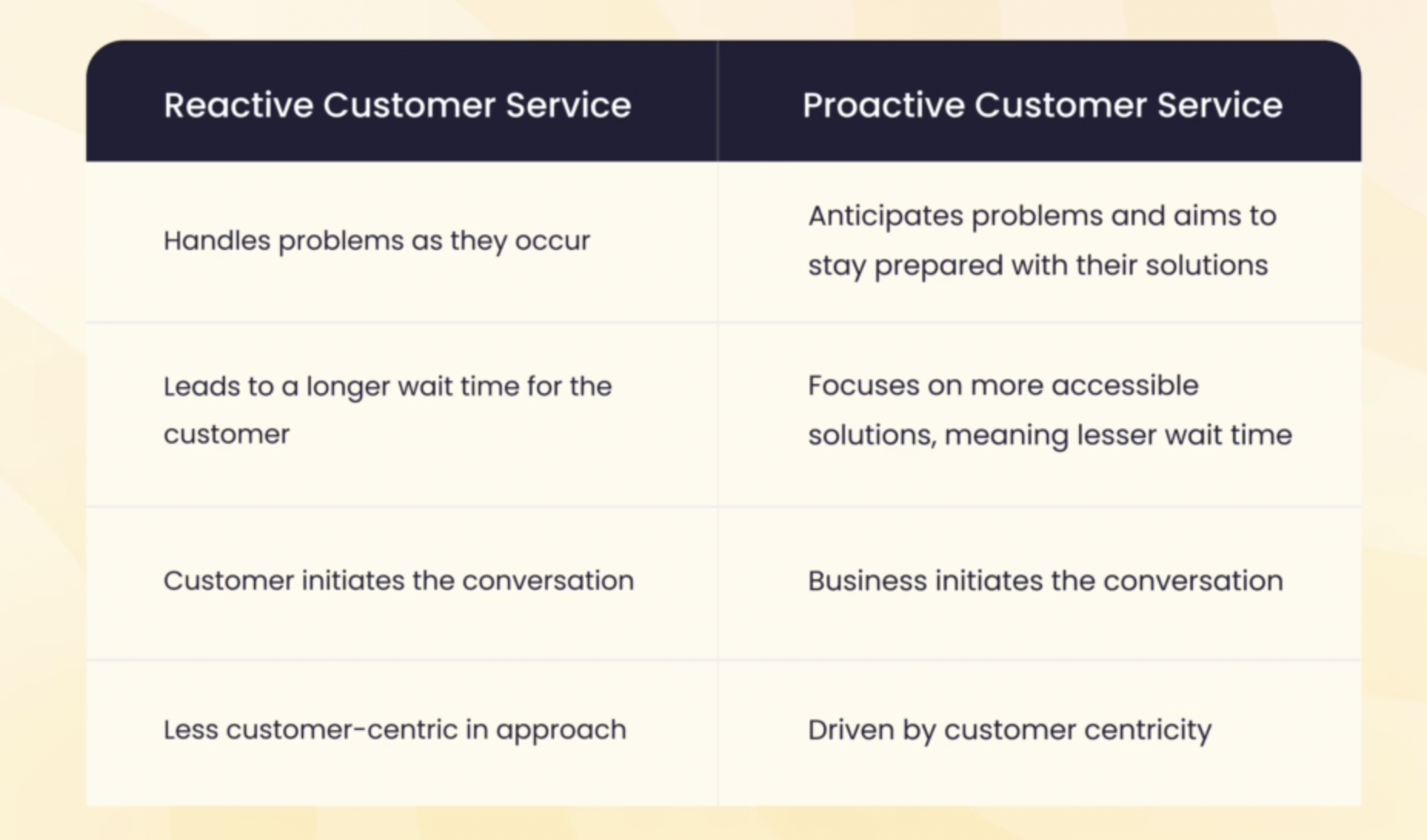
Customers want companies to be proactive, too.
More than 85% of customers want to experience proactive communication and contact from a business.
Being able to offer a solution before a customer voices their concern or, better, before they even realize they have a problem is the best way to win a customer’s loyalty.
Conclusion
With 9 out of 10 businesses competing on customer experience, it’s the organizations that take customer experience seriously that will stand out from the noise and win loyal customers over.
One thing is for sure; in order to deliver a positive experience, you have to know your customers better than ever before.
This means creating complete customer profiles that help you understand and measure the customer experience at every touch point, and across multiple channels.
One way to handle this is by using a CRM.
Once you know your customers well enough, you can use that knowledge to personalize every interaction. Customers these days have more power and choices than ever before. Thus, you are responsible for understanding and acknowledging their needs.
If you make sure their interaction with your company is smooth, pleasant and continuously improving, you will drive brand loyalty. If not, you’ll give your competitors the best gift you can – your customers.
